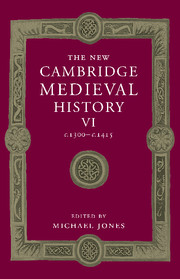Book contents
- Frontmatter
- Part I General Themes
- Part II The States of the West
- 13 The British Isles
- 14 France
- (a) The Last Capetians and Early Valois Kings, 1314–1364
- (b) France Under Charles V and Charles VI
- 15 Italy in the age of Dante and Petrarch
- 16 The empire
- 17 The Low Countries, 1290–1415
- 18 The Iberian Peninsula
- Part III The Church and Politics
- Part IV Northern and Eastern Europe
- Appendix Genealogical Tables
- Primary Sources and Secondary Works Arranged by Chapter
- Index
- Frontispiece
- Plate section
- Map 4 Europe's trade, c. 1300
- Map 5 Europe's trade, c. 1400
- Map 7 The Hundred Years War to 1360
- Map 15 Russia, c. 1396
- Map 17 The Byzantine empire in the 1340s
- References
(a) - The Last Capetians and Early Valois Kings, 1314–1364
from 14 - France
Published online by Cambridge University Press: 28 March 2008
- Frontmatter
- Part I General Themes
- Part II The States of the West
- 13 The British Isles
- 14 France
- (a) The Last Capetians and Early Valois Kings, 1314–1364
- (b) France Under Charles V and Charles VI
- 15 Italy in the age of Dante and Petrarch
- 16 The empire
- 17 The Low Countries, 1290–1415
- 18 The Iberian Peninsula
- Part III The Church and Politics
- Part IV Northern and Eastern Europe
- Appendix Genealogical Tables
- Primary Sources and Secondary Works Arranged by Chapter
- Index
- Frontispiece
- Plate section
- Map 4 Europe's trade, c. 1300
- Map 5 Europe's trade, c. 1400
- Map 7 The Hundred Years War to 1360
- Map 15 Russia, c. 1396
- Map 17 The Byzantine empire in the 1340s
- References
Summary
the premature death of Philip IV on 29 November 1314 proved to be a major turning-point in the fortunes of Capetian France. It coincided with clear signs of an economic crisis, European in scale, that provides a backdrop to the political events which are the main concern of this chapter. Poor harvests, dearth and disease, following several wet summers, caused widespread misery as ‘the Great Famine’ of 1315–17 took its toll of men and animals. Ypres in Flanders lost 10 per cent of its population in these years; losses elsewhere in northern France approached this magnitude. In many regions (Normandy, Forez, Haute Provence) the medieval population peak was passed. Paris, the greatest city and intellectual capital of the west, topped 200, 000 inhabitants before disease, war and political troubles reduced it by two-thirds in the next hundred years. Its hinterland, the Ile-de-France, the ancient heart of the royal domain, which was amongst the most densely settled and richest parts of the kingdom around 1300, was within fifty years devastated by plague and war. In May 1358, partly consequent upon the general economic crisis, partly on short-run political and military factors, the Jacquerie, a violent revolt of rural artisans and craftsmen, broke out in the Beauvaisis and quickly affected an area from Picardy in the north to Orléacute;ans in the south. The particular target of the Jacques was the nobility, blamed for dereliction of duty and recent military defeat.
- Type
- Chapter
- Information
- The New Cambridge Medieval History , pp. 388 - 421Publisher: Cambridge University PressPrint publication year: 2000
References
- 1
- Cited by

